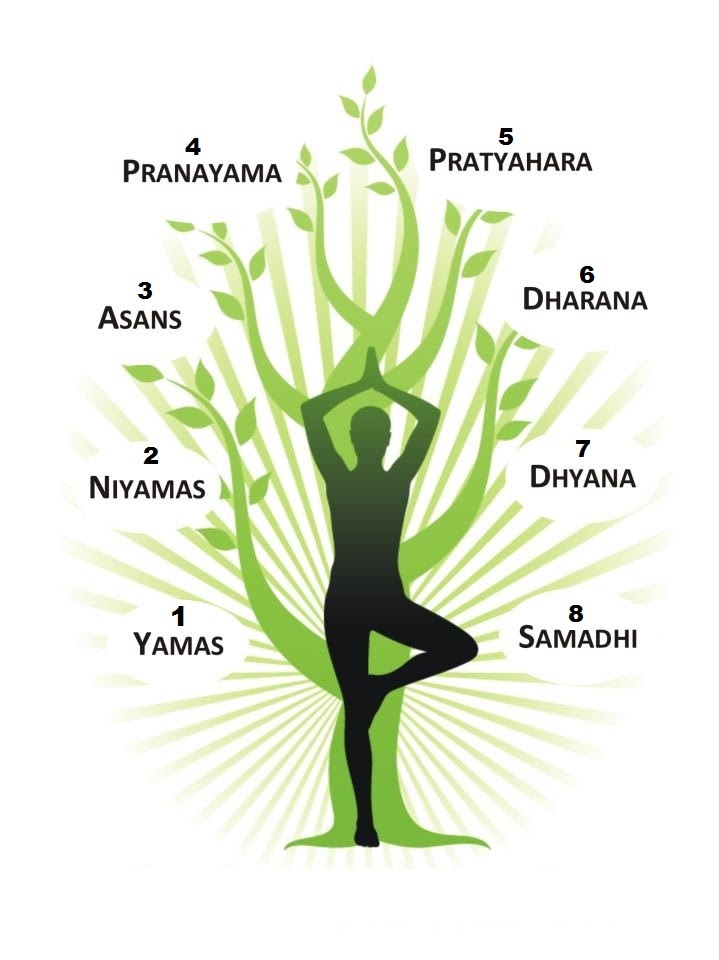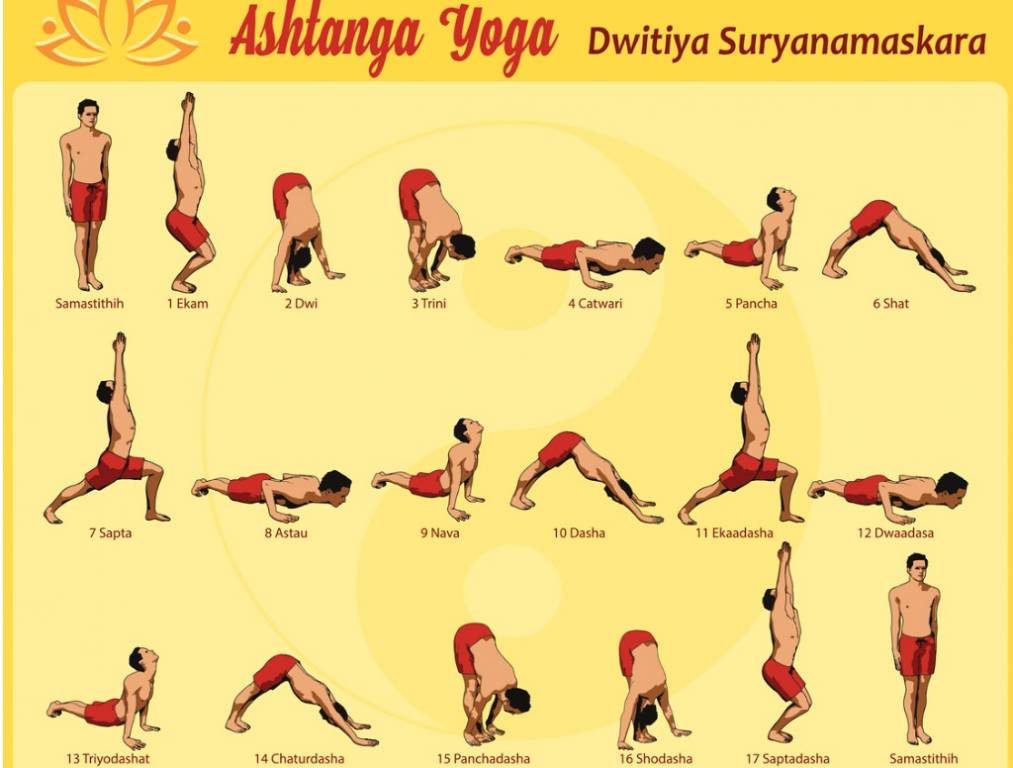Ashtanga Yoga, a category in Patanjali’s Yoga Sutras, emphasizes achieving optimal mental and physical health through ethical living, meditation, discipline, inner and outer cleansing, and physical exercises.
The goal of Ashtanga Yoga is to align one’s inner energy with the external world through ethical actions, meditation, discipline, and exercises. Achieving this involves practicing the “eight limbs” of Ashtanga Yoga, outlined by Patanjali in his Yoga Sutras.
Who Can Learn Ashtanga Yoga?
Whether you’re a beginner or a seasoned yogi, Ashtanga yoga welcomes all levels. Beginners can start with foundational classes, while those with yoga experience can delve into advanced Ashtanga practices.
Ashtanga Yoga Benefits
- Focus on Breath, Poses, and Meditation: Aligns with the principles of hatha yoga for a holistic practice.
- Improved Flexibility: Regular practice enhances flexibility, promoting better body movement.
- Enhanced Breathing: Emphasizes breath control, contributing to improved respiratory function.
- Balanced and Centered Living: Cultivates mental calmness, clarity, and better concentration in daily life.
- Physical Fitness: Increases stamina, bone density, and muscle strength for overall well-being.
- Weight Management: Aids in controlling body weight and promoting a healthy lifestyle.
- Blood Pressure Regulation: Regular practice may contribute to maintaining lower blood pressure levels.
- Stress Relief: Offers mental and spiritual benefits, relieving stress and promoting mental well-being.
- Spiritual Growth: Fosters spiritual development, creating a harmonious connection between mind, body, and spirit.
Tips For Practicing Ashtanga Yoga
- Start slow in Ashtanga yoga, understanding each move before tackling a full session—avoid overdoing it initially.
- Practice is key; memorize postures, ensure precision, and be mindful of body sensations and breathing. Avoid misalignment to prevent injuries.
- Don’t compare; concentrate on your breath, not others. Progress at your own pace, staying mindful and improving skills gradually.
Eight Limbs Of Ashtanga Yoga

The eight steps of ASHTANGA YOGA represent both a sequence of growth, like steps, and an organic unity, like limbs of the body. Each step is interconnected, forming a cohesive system rather than individual rungs on a ladder. This holistic approach emphasizes the internal and external unity of the practice, reflecting the profound interconnectedness of each aspect of yoga.
Explore the essence of Yoga through an overview of its 8 Limbs.
- Yamas: Universal ethical practices focusing on morality and external disciplines, such as non-violence and truthfulness.
- Niyamas: Personal observances and internal disciplines, emphasizing self-discipline and spiritual practices like cleanliness and contentment.
- Asana: Physical postures that cultivate discipline and concentration, treating the body as a temple.
- Pranayama: Breath control techniques regulating the vital life force, connecting breath, mind, and emotions.
- Pratyahara: Withdrawal of senses, redirecting awareness internally and promoting detachment from external stimuli.
- Dharana: Concentration, focusing the mind by eliminating external distractions.
- Dhyana: Meditative absorption, achieving a state of awareness without focus and minimal mental activity.
- Samadhi: Union and integration, the ultimate stage where the meditator transcends the self, connecting with the Divine and achieving a sense of oneness with the universe.
These stages lead to a holistic approach at Dharana Wellness Centre, nestled in the Sahyadri mountain range, emphasizing yoga, pranayama, and meditation for cleansing and healing the body, mind, and spirit.
Ashtanga Yoga Poses
Modern Ashtanga Yoga Poses
Ashtanga Yoga comprises two types of poses:
Sun Salutation A (Surya Namaskar A )Pose

Pranamasana-Starting Pose:
Hands in prayer position.
Hasta Uttanasana-Raised Arms Pose:
Stretching the body.
Padahastasana-Forward Bend Pose:
Hands reaching the floor.
Ashwa Sanchalana-Equestrian Pose:
One leg extended back.
Forming an inverted V with the body.
Sun Salutation B (Surya Namaskar B )Pose

A deep squat with arms raised.
Uttanasana–Standing Forward Bend Pose:
Reaching towards the floor.
Ardha Uttanasana–Standing Half Forward Bend Pose:
Elongating the spine.
Chaturanga Dandasana–Low Plank Pose:
A challenging arm balance.
Urdhva Mukha Svanasana–Upward-Facing Dog Pose:
Chest lifted with arms straight.
For more information on Ashtanga Yoga Poses, you may fill the form click here.
Ashtanga Yoga For Weight Loss
Ashtanga yoga is a challenging and intense form of yoga that can help with weight loss by burning calories and toning muscles. However, it’s not a guaranteed weight loss solution, and results vary for each individual. To see significant changes, combine regular Ashtanga practice with a healthy diet and other physical activities. Remember, it’s about creating a holistic, healthy lifestyle rather than relying solely on yoga for weight loss. Ashtanga, also known as eight-limbed yoga, is detailed in the Yoga Sutras by Patanjali, emphasizing patience and dedication in practicing various asanas.
How Many Calories Should You Expect To Burn After An Ashtanga Yoga Practice?
Calorie burn in yoga relies on workout intensity and your weight. For significant weight loss, aim for strenuous Ashtanga yoga 3-4 times a week. The calories burned vary based on factors like age, gender, weight, and practice duration.
| Duration | Caloric Burn Range |
|---|---|
| 15 mins | 100-250 cals |
| 30 mins | 225-300 cals |
| 60 mins | 450-550 cals |
| 120 mins | 900-1000 cals |
How Often Should You Practice Ashtanga Yoga To Maximize Your Calorie Burn?
Consistent Ashtanga Yoga is key for results, beyond physical challenges. Include stress-reducing asanas for mental well-being, crucial for weight loss dedication and sticking to a diet plan.
| Frequency | Caloric Burn Range |
|---|---|
| 1x1h/week | 400-550 cals |
| 2x1h/week | 1000 cals |
| 3x1h/week | 1500-1600 cals |
| 4x1h/week | 1600-2000 cals |
For more information on Weight Loss, you may fill the form click here.
Ashtanga Yoga For Beginners
Can Beginners Do Ashtanga Yoga?
While Ashtanga yoga is intricate and physically demanding, beginners are welcome to embark on this practice. Its structured sequences offer clear insights into personal progress. The primary series, like Yoga Chikitsa, prioritizes foundational movements, making it beginner-friendly. The emphasis on individual guidance in Mysore-style classes ensures correct asana execution, aiding in a fulfilling yoga journey.
Beginner Ashtanga Yoga Poses
Try this easy yet effective yoga pose for a quick core stretch. Stand tall, raise your hands overhead, and press upwards while engaging your muscles for a thorough full-body stretch.
Hand to Big Toe Pose
Start in mountain position, feet hip-width apart, and arms by your side. Inhale, lift the torso, and circle arms upward. Exhale, maintain a long spine, bend forward from the hips, placing hands on the floor. Place thumbs on big toes, index/middle fingers beneath, avoiding knee overextension. Breathe, stretching the spine on inhalation, and deepening the fold on exhalation. Release the hold, stay folded, then slowly roll up, vertebra by vertebra, for a soothing stretch.
Standing Forward Bend Hands Under Feet Pose
Exhale, straighten and bend at the hips, hands on the ground, maintaining a long front body. Bend knees as needed. Turn palms up, tuck under feet, ensuring wrists align at the base of toes. Adjust weight distribution. Optionally, extend elbows outward and forward, keeping the back of the neck long. Stay for up to eight breaths before gently rising to your feet.




